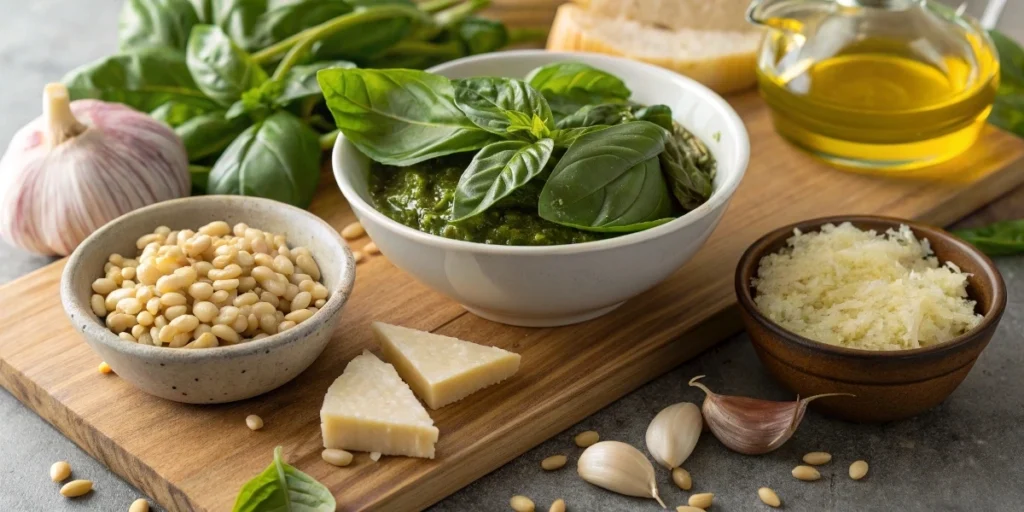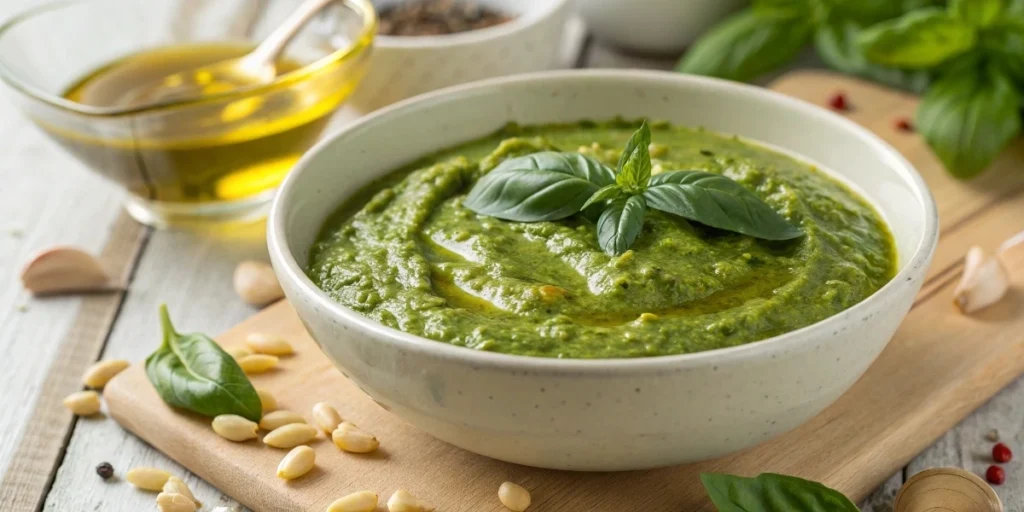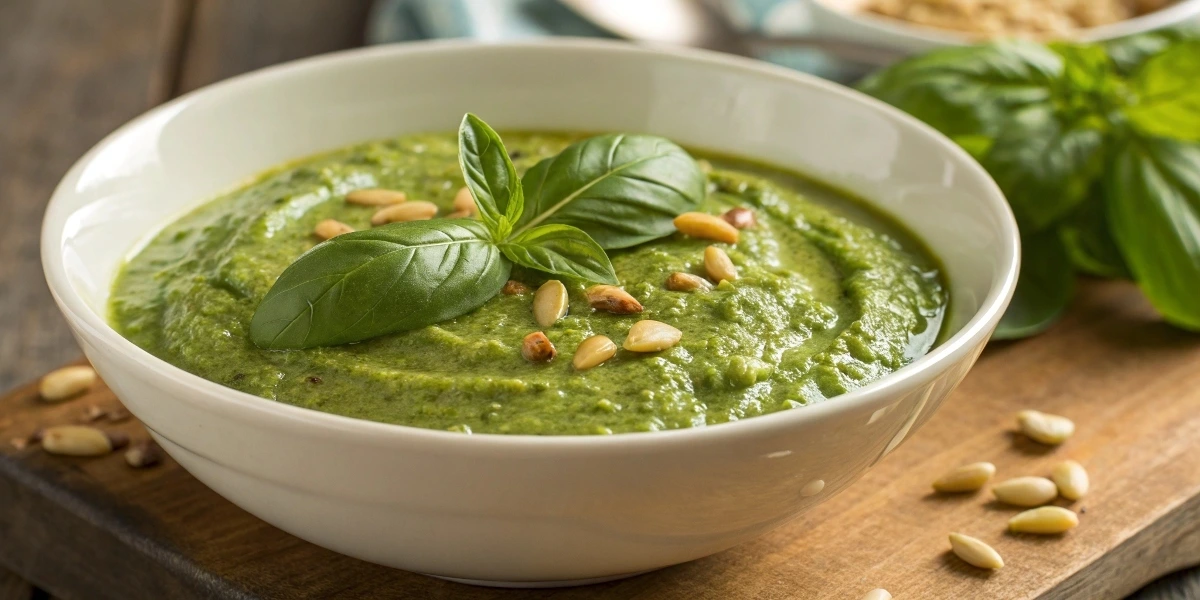Have you ever tasted pesto sauce and wondered how something so delicious could come from just a handful of ingredients? What if I told you that making pesto sauce at home is not only easy but also incredibly rewarding? Whether you’re a beginner in the kitchen or a seasoned cook, homemade pesto can elevate any meal. In this guide, we’ll show you how to make the perfect pesto sauce from scratch—fast, fresh, and full of flavor. By the end, you’ll never reach for store-bought pesto again.
Table of Contents
Overview: Why Homemade Pesto Sauce Is So Special?
Pesto sauce is one of those kitchen staples that’s as versatile as it is delicious. Originating from Italy, traditional pesto (also known as Pesto alla Genovese) is made with fresh basil, pine nuts, garlic, Parmesan cheese, olive oil, and a touch of salt. The blend of these ingredients creates a fresh, herbaceous flavor that can be used in pastas, sandwiches, soups, salads, and more.
What makes this recipe particularly special is how quick and easy it is to make. In just 10-15 minutes, you can have a batch of pesto sauce ready to enjoy. Unlike store-bought versions, homemade pesto offers a burst of vibrant flavors and is customizable to suit your tastes. Plus, it’s much healthier, as you have complete control over the quality of ingredients.
Difficulty Level
The difficulty of making homemade pesto sauce is easy to moderate—it’s an approachable recipe for beginners, and you don’t need any fancy kitchen equipment. A food processor or blender does most of the work, but you can also prepare pesto the traditional way with a mortar and pestle if you’re feeling adventurous.
Essential Ingredients for Homemade Pesto Sauce

1. Basil (the heart of the pesto)
The fresh basil leaves are what give pesto sauce its distinct, aromatic flavor. Look for bright green, fragrant leaves with no wilting or discoloration. If fresh basil isn’t available, you can substitute with spinach or arugula for a different flavor profile, although they won’t have quite the same essence as basil.
2. Pine Nuts (a creamy texture and mild flavor)
Pine nuts are the traditional nut used in pesto. They add a creamy texture and a subtle, slightly sweet taste to the sauce. However, pine nuts can be expensive, and they are often not available in all areas. Walnuts or cashews can be used as alternatives, each offering a different taste and texture. If you’re on a budget, sunflower seeds can be a great budget-friendly option.
3. Garlic (for that bold punch)
Garlic is essential for giving your pesto sauce the signature kick that makes it so irresistible. The key here is to use fresh garlic cloves—no powdered garlic allowed! You can adjust the amount depending on how garlicky you like your pesto.
4. Parmesan Cheese (for richness)
A good-quality Parmesan cheese is non-negotiable. It adds the perfect amount of saltiness and depth to the sauce. If you prefer a vegan version of pesto, you can replace the Parmesan with nutritional yeast or a vegan Parmesan alternative.
5. Olive Oil (smooth and rich)
Olive oil acts as the base that holds everything together while adding richness to the pesto. Opt for a high-quality extra virgin olive oil for the best flavor. If you don’t have olive oil, avocado oil can be a suitable replacement, although it will slightly alter the flavor.
6. Salt (enhancing the flavors)
Just a pinch of salt is needed to bring out the flavors in your pesto sauce. Taste as you go, and add more if needed.
Alternative Ingredients:
- If you don’t have pine nuts, use pecans, almonds, or macadamia nuts.
- Lemon zest or juice can brighten the sauce, giving it a slightly tangy edge.
- For a dairy-free pesto, omit the Parmesan and use a nutritional yeast substitute or another plant-based cheese.
Step-by-Step Instructions: How to Prepare Pesto Sauce?

Making homemade pesto sauce is simple! Follow these steps for a rich, flavorful pesto sauce that will have your taste buds dancing.
Step 1: Prep the Basil
Begin by washing your fresh basil leaves thoroughly to remove any dirt. Pat them dry with a paper towel or use a salad spinner. You want the leaves to be dry before you blend them, so they don’t add excess water to the pesto.
Step 2: Toast the Nuts (Optional)
To enhance the flavor of the pine nuts, you can lightly toast them. Place them in a dry skillet over medium heat, stirring occasionally, for about 3-5 minutes until they turn golden brown. This step is optional, but it adds a lovely, roasted note to the pesto. Be sure to keep an eye on them, as nuts can burn quickly.
Step 3: Blend the Ingredients
Add your basil leaves, pine nuts, garlic, and Parmesan to a food processor or blender. Pulse a few times until everything is finely chopped but not pureed. This will give your pesto sauce a nice, rustic texture.
Step 4: Add Olive Oil
While the processor is running, gradually drizzle in your olive oil. Continue blending until the pesto becomes a smooth, creamy sauce. If it’s too thick, add a little more olive oil until you reach your desired consistency.
Step 5: Season
Taste your pesto and adjust the seasoning. Add salt and pepper to taste, and feel free to add a little extra garlic or Parmesan if you like a stronger flavor.
Step 6: Enjoy!
Your pesto is now ready to be enjoyed! You can toss it with freshly cooked pasta, spread it on sandwiches, drizzle it over roasted vegetables, or even use it as a dip.
Assembly: How to Serve and Present Pesto Sauce?
There are countless ways to use pesto sauce in your meals! Here are a few ideas to get you started:
Pesto Pasta
Toss freshly cooked pasta (spaghetti, penne, fusilli, or your favorite type) with a generous amount of pesto sauce for a simple and flavorful meal. You can add grilled chicken, roasted vegetables, or sun-dried tomatoes to customize it.
Pesto Pizza
Spread pesto as the base sauce for your pizza instead of traditional tomato sauce. Add your favorite toppings, such as mozzarella, arugula, and olives, for a unique twist.
Pesto Sandwich or Wrap
Spread pesto on a sandwich or wrap for an extra burst of flavor. Pair it with roasted vegetables, mozzarella, and a drizzle of balsamic glaze for a delicious bite.
Pesto Dips
Serve pesto as a dip for crackers, chips, or fresh veggies. It also works great as a topping for grilled chicken or fish.
Storage and Makeup Tips: How to Keep Pesto Fresh?
Pesto is best enjoyed fresh, but it can also be stored for later use. Here’s how to keep your homemade pesto sauce fresh:
Storage Tips:
- Refrigeration: Store pesto in an airtight container in the fridge for up to 4-5 days. To prevent the pesto from browning, you can drizzle a thin layer of olive oil on top of the pesto before sealing the container.
- Freezing: Pesto freezes wonderfully! Spoon the pesto into an ice cube tray and freeze in small portions. Once frozen, transfer the cubes to a freezer-safe bag or container for up to 3 months. When you’re ready to use it, simply thaw the pesto in the fridge or microwave.
Reheating:
To reheat pesto, place it in a small saucepan over low heat. Add a little extra olive oil to loosen it up if needed. Avoid overheating the pesto, as it may lose its fresh flavor.
Recipe Variations: Get Creative with Pesto sauce
While the classic basil pesto is a favorite, there are plenty of creative ways to switch it up:
- Sun-Dried Tomato Pesto: Add sun-dried tomatoes to the mix for a tangy, rich variation.
- Arugula Pesto: Swap out the basil for peppery arugula for a more robust flavor.
- Kale Pesto: Use kale leaves for a nutritious and hearty twist on traditional pesto.
- Vegan Pesto: Omit the Parmesan cheese and use nutritional yeast instead for a plant-based version.
- Spicy Pesto: Add a pinch of red pepper flakes for a spicy kick!
Conclusion: Why You Should Make Pesto Sauce at Home?
Homemade pesto sauce is one of those culinary wonders that takes just a few ingredients to create something truly spectacular. It’s fresh, flavorful, and packed with nutrients. Plus, it’s versatile enough to be used in a variety of dishes. Whether you’re making pasta, pizza, or sandwiches, pesto sauce is the secret ingredient that will elevate your meals.
So, next time you’re in the kitchen, skip the store-bought jar and try making pesto sauce from scratch. It’s quick, easy, and most importantly—delicious!
FAQs: Answering Your Pesto Questions
1. How can I make pesto sauce without a food processor? You can make pesto with a mortar and pestle! This traditional method takes a bit more time, but it’s a fun way to release the flavors. Simply grind the ingredients by hand until smooth.
2. Is pesto sauce healthy? Yes! Pesto sauce is packed with healthy fats from olive oil and nuts, and basil is a great source of antioxidants. However, because of the olive oil and cheese, it’s best enjoyed in moderation.
3. Can I make pesto ahead of time? Absolutely! Pesto sauce can be made ahead and stored in the fridge for up to 4-5 days, or frozen for longer storage.
4. Can I substitute other nuts in pesto? Yes, you can use walnuts, cashews, or almonds if you don’t have pine nuts. Each nut will provide a slightly different texture and flavor, so feel free to experiment!
5. Can I make pesto sauce without cheese? Yes, you can make a vegan pesto by omitting the Parmesan and substituting it with nutritional yeast for a cheesy flavor.
Give this homemade pesto recipe a try and enjoy the deliciousness.
If you’re looking to infuse your home or office with authentic Moroccan charm, Artisanat Marrakech Maroc offers a stunning collection of handcrafted treasures that reflect the rich cultural heritage of Morocco. From intricate Berber carpets and beautifully carved cedarwood doors to elegant copper and silver ceiling hangings, each piece is carefully crafted to bring timeless beauty to any space. Whether you’re searching for leather poufs, engraved wooden tables, or traditional Fassi tile fountains, this curated selection has something unique for every room and style. Explore the collection and discover one-of-a-kind decor that tells a story at Artisanat Marrakech Maroc .

